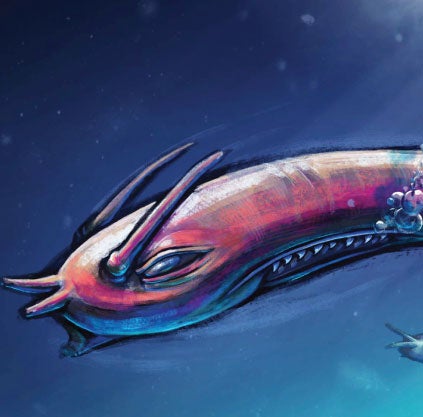 The hagfish is an unusual creature, to say the least. With its two pairs of sharp teeth that protract and retract, it looks like a cross between a worm and a B-movie monster (think Slither or Night of the Creeps). But for one biology professor, this remarkable ancient form of life may hold the key to unlocking some new doors of discovery.
The hagfish is an unusual creature, to say the least. With its two pairs of sharp teeth that protract and retract, it looks like a cross between a worm and a B-movie monster (think Slither or Night of the Creeps). But for one biology professor, this remarkable ancient form of life may hold the key to unlocking some new doors of discovery.
by Andrew Clark
Animals are unquestionably fascinating organisms, many of them possessing the ability to perform spectacular movement. My childhood obsession with animals began with an early exposure to domestic and wild animals, watching television and drawing. I must acknowledge my parents for being cool with their boy exploring his obsession, which translated into an academic journey entailing earning B.S. and Ph.D. degrees, animal-care experiences (as an aquarist for the National Aquarium at Washington, D.C.; as a SCUBA diver for the Miami Seaquarium; and as a zookeeper for the Miami MetroZoo) and various research adventures investigating structural and functional adaptations that animals possess for achieving powerful and rapid movement.
Most of my professional and academic training is grounded in the fields of comparative anatomy and physiology. Within these disciplines, my research specializes in comparative bio-mechanics – a highly engaging topic that interfaces biology with seemingly unrelated academic fields like engineering, physics, materials science, mathematics, computer science and medicine.
Because of its integrative nature, my research experiences have involved a variety of animal subjects, such as fish, lizards, snakes, birds and cockroaches. During the past decade, my research activities have included recording and analyzing two- and three-dimensional body movements, muscle activity and force production from hagfish feeding, lizards running and guinea fowls slipping.
Most of the research being conducted in my lab at the College investigates the morphology and tensile mechanics of biological materials such as hagfish skin and cockroach exoskeletons. Though someone like me may be popularly recognized as a “hagfish guy,” swinging from one critter like a hagfish to another critter like a guinea fowl is easy to do, assuming the questions being asked are provoking (i.e., the questions bear strong intellectual merit and broader impact). With that in mind, you do the best you can to address these questions by carefully planning and conducting your experimental methods and analyses, and ultimately seeing the work through to publication. Being part of a supportive, collaborative research team accelerates this process!
The largest theme in my research program is the biomechanics of jawless feeding in hagfish. At first sight, one might say that a hagfish (e.g., a 30-cm-long Atlantic hagfish) lying at the bottom of an aquarium looks a lot like a 30-cm-long Ballpark Frank, or perhaps like a 30-cm-long eel devoid of scales and eyes. Despite their unprepossessing exterior and soft, boneless construction, hagfish are capable of executing highly acrobatic and forceful movements when feeding. Hagfish possess a formidable set of teeth powered by a soft feeding apparatus that, with the exception of keratinous dentition, looks similar to a Vienna sausage in size, shape, color and passive flexural stiffness.
The first approaches I used to better understand how these teeth work were videotaping live hagfish feeding behaviors in the laboratory and dissecting the feeding apparatuses, or “sausage jaws,” of frozen specimens. Video recordings helped me quantify tooth movements of feeding hagfish while the anatomical dissections and illustrations helped me generate some very interesting questions and hypotheses regarding the biomechanics of tooth function in hagfish. While in graduate school, my colleagues and I discovered that, despite lacking proper jaws and being soft in feeding apparatus and whole body, hagfish could drive their teeth into food items at forces equal to and greater than the bite forces of equally sized jawed vertebrates. Remarkably, the soft muscle and connective tissues comprising the sausage jaws function in moving the teeth while providing a hydrostatic skeleton to support the tooth movements and muscle forces. In other words, the soft hagfish feeding apparatus can behave like a musculoskeletal system even in the absence of a rigid support skeleton (like jaws made of bone or mineralized cartilage).
Soft-bodied marine invertebrates, such as predatory marine worms and octopuses, commonly use this strategy, by which pressurized fluid stiffens soft structures to support forceful biting movements. For several years, Theodore Uyeno (my colleague at Valdosta State University) and I have been perplexed by the resemblance between hagfish biting and octopus biting. We recently have been awarded research funding from the National Science Foundation to investigate these similarities, along with two additional extraordinary traits about the biomechanics of feeding hagfish: their ability to tie their bodies into knots and use the knots for stabilizing and leveraging tooth movements, and their unusually loose skin – which might have contractile abilities – and their soft body core (consisting mostly of muscles arranged more like those in a salamander than in other fish) that mediate their knot formation and manipulation.
For the next three years, the NSF funding will be budgeted for research equipment to be housed in Ted’s lab at VSU and my lab at the College, professional and academic training for undergraduates and graduates at both institutions and international travel to field sites in New Zealand, Japan and Mexico.
It’s another step forward in my obsession with animals and one that may help us understand our world a little bit better.
– Andrew Clark is an assistant professor of biology.
Illustration by Karl Zurflüh




